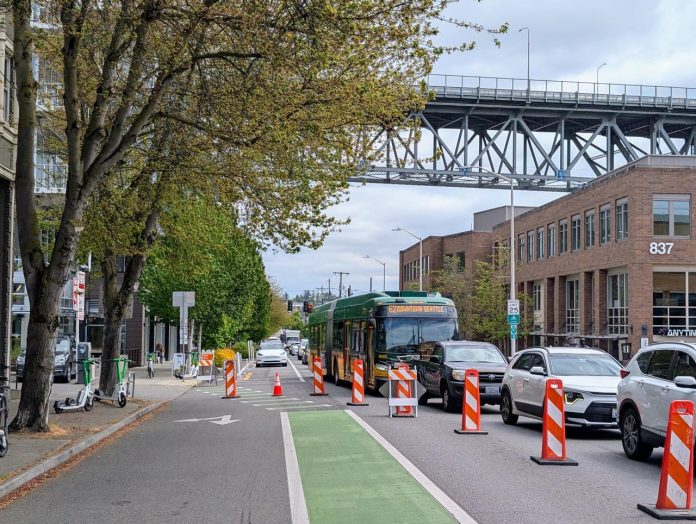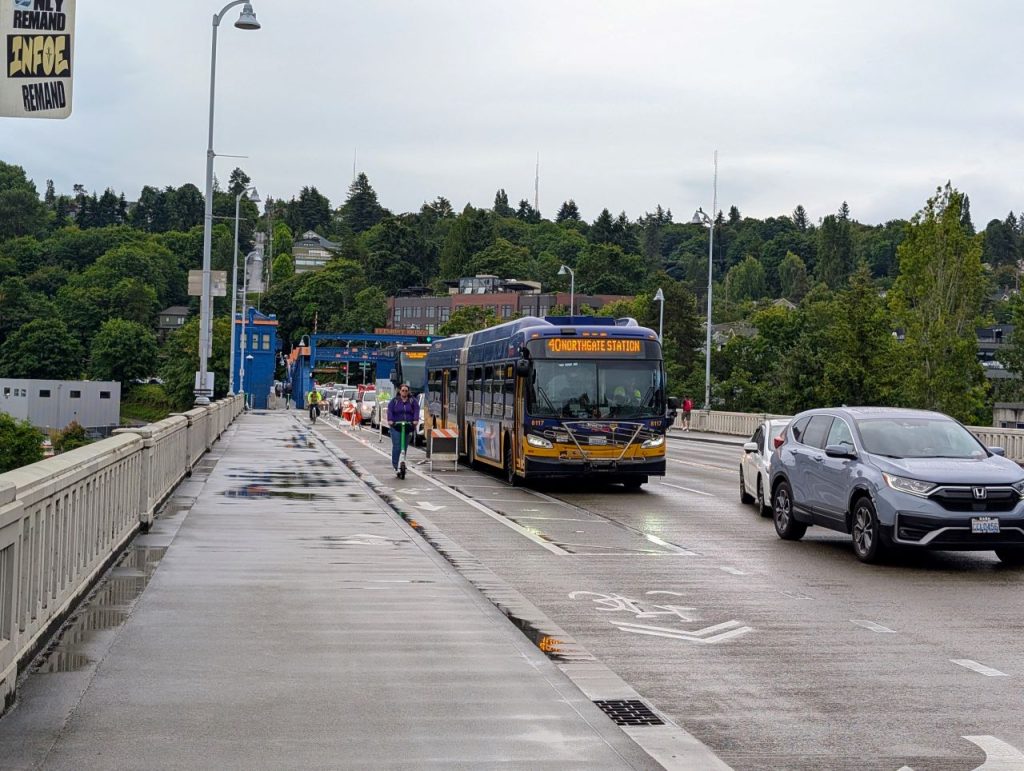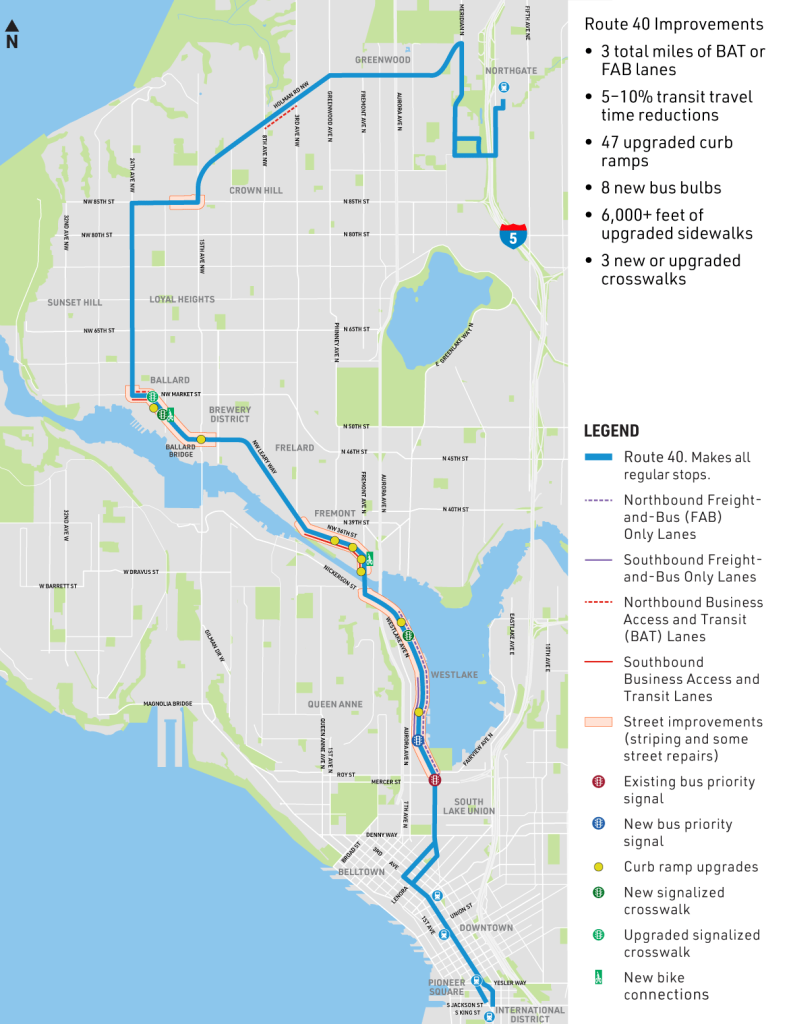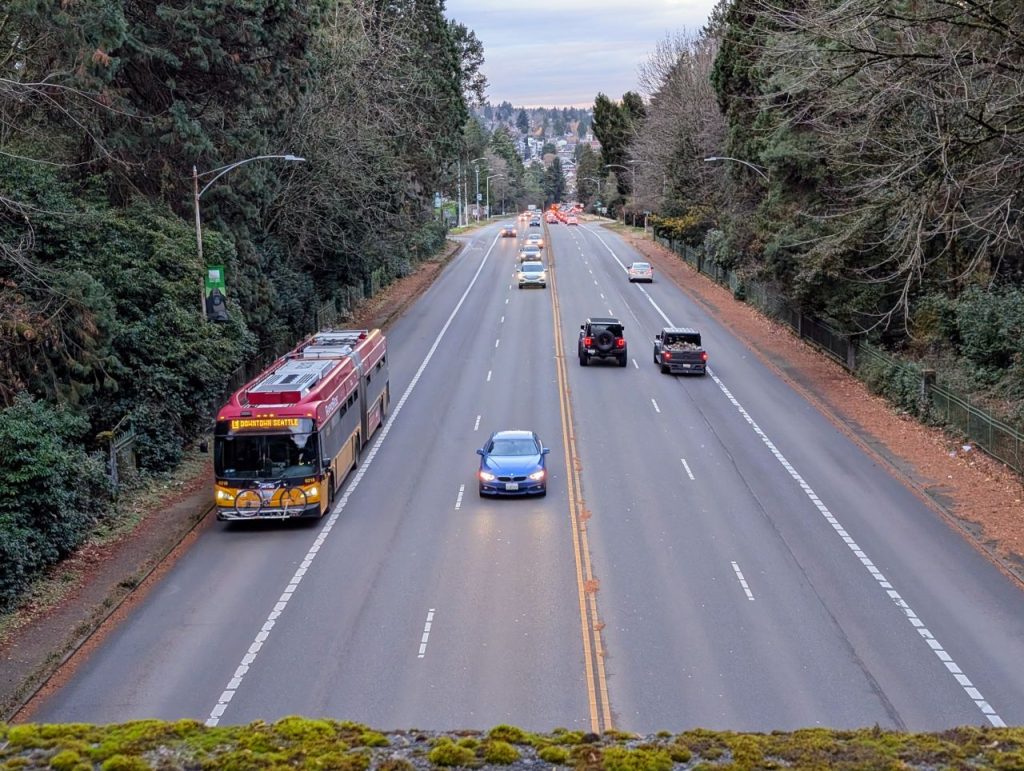
The arrival of summer means two things: Seattleites are bee-lining to beaches and parks to catch up with their forgotten friend, the sun, and the height of construction season is upon us. For bus riders, road work means delays, but King County Metro is seeking to design detours to minimize the pain. Some transit riders argue more mitigation is needed, but improving routes and removing pinch points is largely up to local transportation departments, not Metro.
King County Metro spokesperson Jeff Switzer said the agency has planned ahead to try to lessen the blow as a number of routes are impacted by construction work underway or lined up later this year.
“There isn’t a one-size-fits-all approach to keeping buses moving during construction season, but we stay on time best when transit priority can be integrated into construction traffic control plans prepared by contractors and our jurisdictional partners,” Switzer said. “Also, whenever possible, the ability to set up temporary transit stops and zones relatively close to closed stops helps reduce customer confusion and inconvenience.”
Among the routes to see major construction impacts this year are the RapidRide C, D, and E Lines and Routes 40, 49, 62, 65, 70, 333, and 365.
Routes 31, 32, 40, and 62 are being pinched by work to add a new water main and sewer line along the Lake Washington Ship Canal. Fremont Avenue N is torn up just north of the Fremont Bridge, forcing bus stops to move locations due to lane reductions at the normal N 34th Street stops.
Route 40 is also seeing road work on Leary Way and NW Market Street as part of Move Seattle Levy-funded transit and accessibility upgrades that are adding some stretches of bus lanes. Same goes for Eastlake Avenue with levy-funded Route 70 overhaul.
While the Leary and Eastlake work will put the streets back in a more transit-friendly arrangement than it started, the overhaul of Fremont Avenue may fall short. The bridge appears likely to remain a frequent pinch point in the bus network, as buses get stuck in bridge traffic without proper queue jumps and bus lanes to bypass backups.
Southbound Route 40 buses will benefit from a business access and transit (BAT) lane on Fremont between 35th and 34th Avenues, but the lane disappears on the bridge, and turning movements may still impede buses.
SDOT spokesperson Mariam Ali said that Market Street bus lane installation work is expected to wrap by the second week in July and be ready in time for Ballard SeafoodFest and the crowds it will bring starting Friday, July 11.
“The new bus-only lanes being installed in Crown Hill, Ballard, and along Westlake are being built precisely to address long-standing reliability challenges on Route 40,” Ali said. “In fact, they were just added to Leary and will be added in the other location over the next couple of weeks. These upgrades are designed to help keep buses moving and improve on-time performance for years to come. They’ll also play an important role in keeping people moving during the Revive I-5 work, providing better north-south transit connections as travelers seek alternatives to driving.”

Seattle’s Ship Canal sewer project will impact all traffic at the Fremont Bridge for the remainder of the year, Switzer said.
“The Fremont reroute is the best possible scenario that offers the least amount of service loss,” Switzer told The Urbanist, noting that the Ship Canal Water Quality Project stretches from Fremont to Ballard. “We created reroutes and temporary bus zones to try to keep buses flowing smoothly and limit the impact to riders. The geometry of the neighborhoods there makes traffic, especially when demand is high, difficult for everyone to get through.”
Metro is keeping an eye on the reroutes in case of issues, but alternatives are limited, given the narrow streets in the area.
“We’re monitoring the initial results and will be in ongoing discussions with SDOT,” Switzer said in May. “Each of these routes crosses the Fremont Bridge, so there are not many alternatives in terms of detours.”

Third Avenue will see a repaving between Pine Street and Virginia Street, at a major bus crossroads. Seattle Public Utilities is replacing a water main and SDOT will do a full-depth pavement replacement beginning in July, Switzer said, noting Route 40 and the C, D, E and H Lines use this stretch. “Expect partial road closures daily with full road closures on weekends,” he said.
The D Line will also be getting hit by construction work on 15 Avenue NW between West Emerson Street and NW Market Street, which will be ongoing through the summer of 2025. Full weekend closures of the Ballard Bridge had sent the D Line on a major reroute to the Fremont Bridge, but SDOT said no additional full weekend closures of the Ballard Bridge are planned as part of the project.
Denny Way is another downtown thoroughfare that is seeing heavy road work this year. This had led to the already highly unreliable Route 8 becoming even more behind schedule and hard to rely on.

Seattle bus rider Nick Sattele has been active in the Fix the L8 campaign, urging improvement to the frequently delayed Route 8 bus. In 2023, Sattele authored an Urbanist op-ed calling for Denny Way bus lanes as part of a broader “Fix the L8” campaign.
SDOT declined to add more bus priority for Route 8, and now Denny Way road work once again has riders lamenting the route’s sluggishness. Transit faces broader structural threats that make the need for bus lanes and prioritization all the more urgent, Sattele argued.
“Transit in Seattle is facing attacks from all sides with a hostile federal government, looming fiscal cliff, and politicians intervening to delay projects at a time when increasing traffic is leaving our buses with more delays than in 2019,” Sattele told The Urbanist. “We know what works. Route 7 got bus lanes then reliability and ridership spiked to levels higher than 2019. But the rest of the system is in peril with systemwide reliability the worst since 2018 with popular routes like the 8 leading the charge.”
Despite the fact that King County Metro systemwide ridership has not recovered from Covid, systemwide reliability is now the worst it’s been since 2018
— Nick (@nicksattele.bsky.social) June 26, 2025 at 10:37 PM
[image or embed]
Route 8 worsening condition has pushed Fix The L8 activists to plan a “Race the L8” event at 5pm Thursday, July 10. To raise awareness about the bus’s issues, race participants will seek to out-walk the slow-moving bus.

Wes Mills, an advocate and member of the Transit Riders Union, pointed out that bus lanes and better communications around detours and construction impacts would be a big help to riders.
“Metro is largely doing what it can with what it has and yes, reliability during construction or other disruptions dropping, as well as overall, is a symptom of not rolling out the literal red carpet for buses in more places,” Mills told The Urbanist. “On Metro’s end, I think the big thing is communication: maps take a long time to produce, for sure, but bus reroute alerts used to include the new path for the bus and detailed stop information. Riders need information like that, in as many languages and as many sources as far in advance as possible.”
Unfortunately for riders, Metro cannot unilaterally dedicate road space to speed up buses and trains, even though it maintains a list of major pinch points where bus lanes would be most helpful. Dedicating road space is up to the local departments of transportation and the mayors (or city managers) overseeing them. For the Emerald City, that means the Seattle Department of Transportation (SDOT) and Mayor Bruce Harrell are the ones calling the shots on street prioritization.
“SDOT is doing the right things with bus lanes through the Fremont and Ballard chokepoints and finally making the Aurora lanes 24/7, and I’d like to see them go farther,” Mills said. “For construction detours, do like we’ve seen them do on Campus Parkway and make temporary bus lanes. Be more aggressive with removing parking, especially multi-hour spots, to make room for bus lanes — temporary or permanent — and pedestrian pathways around construction. Actual enforcement of those temporary measures is desperately needed (like at Ballard Seafood Fest and the temporary bus stops that get used as parking).”

While the Harrell Administration held firm on Route 40 bus lanes in Ballard despite pushback and is moving forward with Aurora’s E Line bus lanes to help during Revive I-5 road work disruptions, SDOT recently caved when it came to a long-planned Belltown extension of the Third Avenue bus mall. Those Third Avenue bus-only lanes could have helped the 80,000 daily riders who use the corridor, including the aforementioned RapidRide lines that are supposed to be setting a higher standard for reliability and speed.
This summer’s Third Avenue water main project will be more likely to delay transit riders without those bus lanes. The E Line is expected to carry a heavier load during the Revive I-5 work, which will last multiple years, as expected traffic congestion discourages people from driving.
On Seattle’s border with Shoreline, N 145th Street road work is impacting Routes 65, 333, and 365. The road work is between Meridian Avenue N and 5th Avenue NE and will be ongoing through late 2026 as workers add a large roundabout at 145th Street’s I-5 interchange to supercharge traffic flow. Switzer said this would include a full 27-day closure, alternating between affected freeway ramps.
Switzer said the project was designed to reduce transit impacts to the extent possible, with the area taking on added significance in the transit network after Shoreline South Station opened just to the north, becoming a local bus hub for transfers.
Once complete, the roundabout may improve traffic flow for buses, but it could prove a pain for pedestrians to cross. A pedestrian bridge under construction over I-5 will provide an alternative once it opens — currently tabbed for spring 2026.
The slate of construction projects may bring headaches for riders, but it’s the larger pattern of not investing enough in bus service and route improvements that appears to be causing Metro’s larger issues maintaining reliable service and regaining pre-pandemic ridership levels. Metro has two-thirds of the bus ridership it had in 2019, before Covid upended travel patterns and service levels. On the weekends, ridership is much closer to pre-pandemic levels — when much of the scheduled construction work occurs.
“Every summer is a flurry of construction work and outdoor events when it’s ‘finally dry,’” Mills added. “We know what we need to do; we ‘just’ have to do it.”
Correction: The original version of this story incorrectly stated that more full weekend closures of the Ballard Bridge were planned this year. SDOT says it has already completed that part of the repaving project. The article was updated on July 7, with a quote from SDOT’s Mariam Ali added.
Doug Trumm is publisher of The Urbanist. An Urbanist writer since 2015, he dreams of pedestrian streets, bus lanes, and a mass-timber building spree to end our housing crisis. He graduated from the Evans School of Public Policy and Governance at the University of Washington in 2019. He lives in Seattle's Fremont neighborhood and loves to explore the city by foot and by bike.

